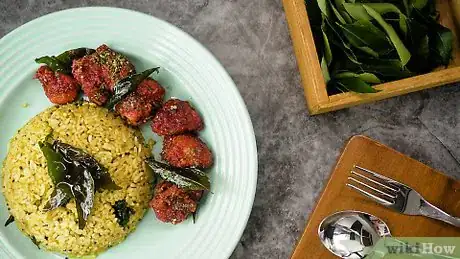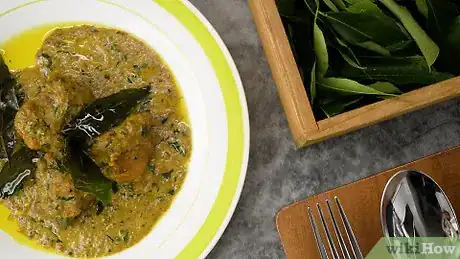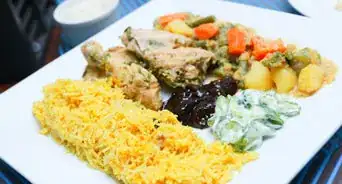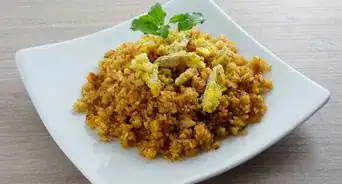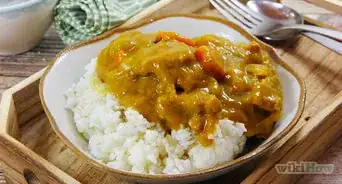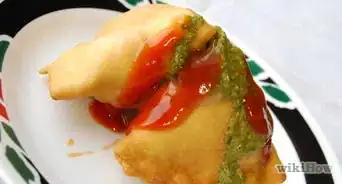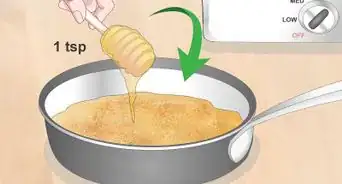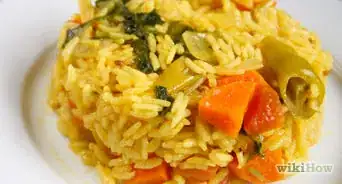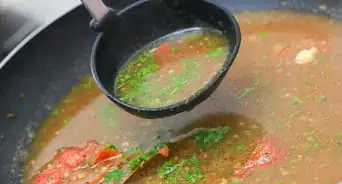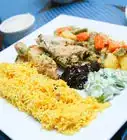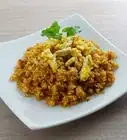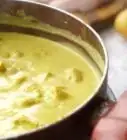This article was co-authored by wikiHow Staff. Our trained team of editors and researchers validate articles for accuracy and comprehensiveness. wikiHow's Content Management Team carefully monitors the work from our editorial staff to ensure that each article is backed by trusted research and meets our high quality standards.
The wikiHow Video Team also followed the article's instructions and verified that they work.
This article has been viewed 85,554 times.
Learn more...
Curry leaves hail from South India, and though their name makes it sound like they’d smell and taste similar to curry powder, that’s far from the truth. They have a strong lemongrass flavor, making them a nice addition to rich dishes once they’ve been sautéd over high heat to release their aromatic flavor. They’re simple to cook with, just taking a few minutes to sauté with oil—you’ll be adding them to your weekly grocery list in no time![1]
Ingredients
Curry Leaves, Mustard Seeds, and Coconut Sauce
- 2 tablespoons (30 mL) of cooking oil or ghee
- 1 teaspoon (2 grams) of mustard seeds
- 6 to 8 fresh curry leaves
- 2 to 3 tablespoons (30 to 44 mL) of coconut milk
Makes enough sauce for 1 meal or 4 dishes
Curry Leaf Chutney
- 1 cup (25 grams) of fresh curry leaves
- 2 tablespoons (10 grams) of sesame seeds
- 2 tablespoons (16 grams) of roasted peanuts
- 1 teaspoon (2.5 grams) of dried mango powder
- 1/2 teaspoon (1.5 grams) of red chili powder
- Pinch of sugar
- Pinch of salt
Makes 1 cup (325 grams) of chutney
Steps
Sautéing Curry Leaves
-
1Buy leaves that are a bright, dark green color. Find fresh curry leaves in the produce section of Asian or Indian markets. You can often find them online, too, just be aware that long shipping times could affect the flavor and vibrancy of the leaves. Avoid leaves that are browning or discolored, as they will probably have a bitter flavor that won’t taste good.[2]
Tip: If you can’t find fresh curry leaves, substitute dried curry leaves in their place. Just use about 1.5 times as many dried curry leaves as you would fresh.
-
2Remove the curry leaves from the stems and rinse them in cool water. To remove the leaves from the stem, simply pluck them off with your thumb and forefinger. Run the leaves under a gentle stream of water and pat them dry with a paper towel. Most dishes call for about 8 to 10 curry leaves, though always follow the recipe to ensure your dish will be flavored properly.[3]
- Wrap unused leaves in a damp paper towel and keep them in the fridge. They won’t last for more than a week, so try to use them before they go bad.
Advertisement -
3Heat 1 to 2 US tbsp (15 to 30 mL) of cooking oil over medium-high heat. Use whichever cooking oil or alternative you prefer: avocado oil, olive oil, coconut oil, grapeseed oil, ghee, and other options will all work to cook the curry leaves. Heat up your choice of oil for 30 to 60 seconds until it’s hot.[4]
- To test if the oil is hot, get some water on your fingertips and flick a few drops into the pan. If the water sizzles, the oil is hot. If the water doesn’t sizzle, it needs more time.
-
4Sauté the curry leaves for 3 to 5 minutes until they’re crisp. Once the oil is hot, add the 8 to 10 curry leaves to the pan. Cook them for 3 to 5 minutes, or until they’ve softened and start to crisp at the edges. Stir them with a wooden spoon from time to time to keep them from burning.[5]
- If the leaves do start to burn, lower the heat to medium.
-
5Cook the rest of your dish with the curry leaves to infuse it with flavor. There are 2 options as to how to use your curry leaves. Pour them and the oil over top of a finished dish, or add them to the base of a dish and keep cooking from that point with the leaves incorporated. If you want the entire dish to be infused with the flavor of the curry leaves, just add your other ingredients right to the pan and keep cooking.[6]
- If you need to transfer your leaves to a bigger dish, use a hot pad or dishtowel to handle the hot pan so you don’t burn yourself.
-
6Set the sautéd leaves to the side to use as a finishing seasoning. If you’d rather use the curry leaves as an accompaniment to your dish rather than tasting the flavor throughout the entire thing, simply remove the pan from the heat and set it to the side once the leaves are sautéd. Make the rest of your dish as you normally would; once it’s done, add the leaves and oil to the dish and enjoy.[7]
- Soups, rice dishes, curries, slices of bread, yogurts, and other dishes are all great options to top with sautéd curry leaves.
Adding Curry Leaves to Different Dishes
-
1Mix curry leaves, mustard seeds, and coconut for a traditional flavor. Over medium-high heat, soften 2 tablespoons (30 mL) of cooking oil or ghee. Add 1 teaspoon (2 grams) of mustard seeds and heat them until they start to sizzle. Then, add 6 to 8 curry leaves to the dish. Cook the leaves and seeds for 2 to 3 minutes, or until the leaves have softened. Turn the heat to low and add 2 to 3 tablespoons (30 to 44 mL) of coconut milk to the pan; cover the pan with a lid and let the ingredients simmer for 4 to 5 minutes. Spoon the mixture over top of soups, rice dishes, or vegetables to infuse them with an aromatic flavor.[8]
- You can modify the measurements and cooking style depending on what you’re making and how much you need. Just keep in mind that coconut, mustard seeds, and curry leaves mix well together and can be used to amp up the flavor of any dish.
-
2Cook a rice dish with sautéd curry leaves to infuse it with flavor. Sauté 8 to 10 curry leaves in hot oil until they get crisp. Once they’re crisp, add your uncooked rice and other ingredients to the pan and cook the meal as you normally would. Stir everything together occasionally to mix the flavor of the curry leaves throughout the rice dish.[9]
- For a flavorful modification, cook your rice with coconut milk instead of water.
-
3Pair your vegetable sides with curry leaves to add a lemon essence. Fry 8 to 10 curry leaves in hot oil, then add your vegetables of choice to the pan and cook them until they’re done. Potatoes, carrots, mushrooms, eggplant, onions, cauliflower, sweet potatoes, spinach, and tomatoes are great vegetable options to pair with curry leaves.[10]
- If you decide to use several different kinds of vegetables, plan out the timing so that you don’t accidentally undercook or overcook anything. For example, spinach needs a lot less time to cook than potatoes do.
-
4Complement curries with curry leaves to infuse them with freshness. You may think that curries already have curry leaves in them, but curry leaves have a distinct flavor separate from that in curry powder. Sauté 8 to 10 curry leaves in a pan of hot oil until they get crisp, then set them to the side while you finish the rest of your dish. Once the curry itself is done, spoon the curry leaves and oil over the top of the dish to add an extra flavor element.[11]
Did You Know? Curry powder is a combination of flavors like turmeric, chili powder, coriander, cumin, ginger, and pepper.
-
5Bake an aromatic loaf of bread by adding chopped curry leaves. For a single loaf of bread, use about 2 tablespoons (2.5 grams) of fresh, chopped curry leaves. Chop them into small pieces, about 1⁄8 inch (0.32 cm) wide. Add a few other aromatic spices, like turmeric and cumin, to complement the flavor of the curry leaves. Add these seasonings to your basic bread recipe and bake it how you normally would.[12]
- Slice your bread and spread butter over top, or eat it alongside another dish like Indian rice or curry.
-
6Make a chutney to add to many dishes for an instant infusion of flavor. Measure out 1 cup (25 grams) of fresh curry leaves, 2 tablespoons (10 grams) of sesame seeds, 2 tablespoons (16 grams) of roasted peanuts, 1 teaspoon (2.5 grams) of dried mango powder, 1/2 teaspoon (1.5 grams) of red chili powder, and a pinch each of sugar and salt. Roast the curry leaves in a dry pan over medium-high heat until they dry out and start to crumble. Use a grinder to combine all the ingredients until they have a coarse consistency. Sprinkle the chutney over rice, soup, vegetables, bread, or salted yogurt.[13]
- Store this chutney in the fridge in an airtight container. It’ll be good for about a week if you haven’t eaten it all before then!
Community Q&A
-
QuestionCan I make a tea out of curry leaves?
 Ishika SaagarCommunity AnswerYes, it's possible to make tea out of curry leaves. You could also make buttermilk with ground dried curry leaves. It might not taste great, so a little sugar could help.
Ishika SaagarCommunity AnswerYes, it's possible to make tea out of curry leaves. You could also make buttermilk with ground dried curry leaves. It might not taste great, so a little sugar could help. -
QuestionI have a curry plant in my herb garden but have never used it, I don't know how, any suggestions?
 Community AnswerYou can make delicious herbal tea using the leaves! It makes for a perfect alternative to regular tea, coffee or hot chocolate.
Community AnswerYou can make delicious herbal tea using the leaves! It makes for a perfect alternative to regular tea, coffee or hot chocolate.
Warnings
- Avoid using raw curry leaves in your dishes. Cooking them thoroughly will remove any potentially harmful bacterias that could make you sick.⧼thumbs_response⧽
Things You’ll Need
Sautéing Curry Leaves
- Paper towel
- Sauté pan
- Wooden spoon
References
- ↑ https://www.bonappetit.com/story/what-are-curry-leaves
- ↑ https://www.npr.org/2011/09/28/140735689/fresh-curry-leaves-add-a-touch-of-india
- ↑ https://www.npr.org/2011/09/28/140735689/fresh-curry-leaves-add-a-touch-of-india
- ↑ https://www.foodrepublic.com/2017/11/21/use-curry-leaves/
- ↑ https://www.foodrepublic.com/2017/11/21/use-curry-leaves/
- ↑ https://www.npr.org/2011/09/28/140735689/fresh-curry-leaves-add-a-touch-of-india
- ↑ https://www.thekitchn.com/i-cooked-with-curry-leaves-for-the-first-time-and-heres-what-i-made-222351
- ↑ https://www.foodrepublic.com/2017/11/21/use-curry-leaves/
- ↑ https://www.npr.org/2011/09/28/140735689/fresh-curry-leaves-add-a-touch-of-india
- ↑ https://www.npr.org/2011/09/28/140735689/fresh-curry-leaves-add-a-touch-of-india
- ↑ https://www.npr.org/2011/09/28/140735689/fresh-curry-leaves-add-a-touch-of-india
- ↑ https://www.npr.org/2011/09/28/140735689/fresh-curry-leaves-add-a-touch-of-india
- ↑ https://www.npr.org/2011/09/28/140735689/fresh-curry-leaves-add-a-touch-of-india
About This Article
Curry leaves can infuse your dishes with a with a rich, lemony flavor. To release the flavor of the leaves, you’ll need to cook them in oil. Remove the leaves from their stems and rinse them in cool water, then set them aside. Heat 1 to 2 tablespoons of your favorite cooking oil for 30 to 60 seconds in a skillet over medium-high heat, then add the leaves. Stir them occasionally with a wooden spoon until they start to crisp up, usually after 3 to 5 minutes. Then you can incorporate the leaves into a dish as it cooks to add flavor. Keep reading for tips on how to use curry leaves into a variety of foods!



